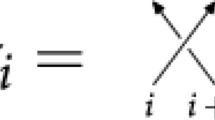Abstract
Using the duality equations of Moore and Seiberg we define for every primary field in a Rational Conformal Field Theory a proper Markov trace and hence a knot invariant. Next we define two nested algebras and show, using results of Ocneanu, how the position of the smaller algebra in the larger one reproduces part of the duality data. A new method for constructing Rational Conformal Field Theories is proposed.
Similar content being viewed by others
References
Belavin, A.A., Polyakov, A.M., Zamolodchikov, A.B.: Infinite conformal symmetry in two dimensional quantum field theory. Nucl. Phys. B241, 333 (1984)
Moore, G., Seiberg, N.: Classical and quantum conformal field theory. Commun. Math. Phys.123, 177 (1989)
Moore, G., Seiberg, N.: Taming the conformal Zoo. Phys. Lett.B 220, 422 (1989)
Kauffman, L.H.: On knots. Ann. Math. Stud. vol. 115, Princeton, NJ: Princeton University Press 1987
Li, M., Yu, M.: Braiding Matrices, modular transformations and topological field theories in 2+1 dimensions. Commun. Math. Phys.127, 195 (1990) Li, M.: Duality and modular invariance invariance in rational conformal field theories. Copenhagen preprint NBI-HE-90-12 Degiovanni, P.: Topological field theory and rational conformal field theory, preprint LPTENS 89/25
Verlinde, E.: Fusion rules and modular transformations in 2D conformal field theory. Nucl. Phys.B 300, 360 (1988)
Jones, V.F.R.: A polynomial invariant for knots via von Neumann algebras. Bull. Am. Math. Soc.12, 103 (1985)
Kauffman, L.H.: State models and the Jones polynomial. Topology26, 395 (1987)
Ocneanu, A.: Quantized groups, string algebras and Galois theory for algebras. In: operator algebras and applications, Vol. II. LMS vol. 136, 1988
Jones, V.F.R.: Index for subfactors. Invent. Math.72, 1 (1983)
Murray, F., von Neumann, J.: On rings of operators. IV. Ann. Math.44, 716 (1943)
Connes, A.: Ann. Math.104, 73 (1976)
Goodman, F.M., de la Harpe, P., Jones, V.F.R.: Coxeter graphs and Towers of algebras. Berlin, Heidelberg, New York: Springer 1989
Witten, E.: Gauge theories and integrable lattice models. Nucl. Phys. B322, 629 (1989)
Witten, E.: Gauge theories, vertex models and quantum groups. Nucl. Phys. B330, 285 (1990)
Witten, E.: Quantum field theory and the Jones polynomial. Commun. Math. Phys.121, 351 (1989)
Reshetikhin, N.: Quantized universal envelopping algebras, the Yang-Baxter equation and invariants of links, LOMI preprints E-17-87
Wadati, M., Deguchi, T., Akutsu, Y.: Exactly solvable models and knot theory. Phys. Rep.180, 247–332 (1989)
Pasquier, V., Saleur, H.: Common structures between finite systems and conformal field theories through quantum groups. Nucl. Phys.B 330, 523 (1990)
Longo, R.: Index of subfactors and statistics of quantum fields. Commun. Math. Phys.126, 217 (1989)
Alvarez-Gaumé, L., Gomez, C., Sierra, G.: Duality and quantum groups. Nucl. Phys.B 330, 347 (1990); Topics in conformal field theory: Contribution to the Knizhnik Memorial Volume. Brink, L., Friedan, D., Polyakov, A.M. (eds.). Singapore: World Scientific
Cvetković, D.M., Doob, M., Sachs, H.: Spectra of graphs, theory and application. New York: Academic Press 1980
Mathur, S.D., Mukhi, S., Sen, A.: On the classification of rational conformal field theories. Phys. Lett.B 213, 303 (1988)
Christe, P., Ravanini, F.: A new tool in the classification of rational conformal field theories. Phys. Lett.B 217, 252 (1989)
Dijkgraaf, R., Vafa, C., Verlinde, E., Verlinde, H.: The operator algebra of orbifold models. Commun. Math. Phys.123, 485 (1989)
Schellekens, A.N., Yankielowicz, S.: Cern preprint TH.5483/89
Naulich, S.G., Riggs, H.A., Schnitzer, H.J.: Group level duality in WZW-models and Chern-Simons theory, Brandeis preprint BRX-TH-293
Marcus, D.A.: Number fields. Berlin, Heidelberg, New York: Springer 1977
Ocneanu, A.: Harmonic analysis on group quotients (preprint)
Serre, J.-P.: Linear representations of finite groups. Grad. Texts Math. vol.42. Berlin, Heidelberg, New York: Springer 1977
Evans, D.E., Gould, J.D.: Dimension groups, Embeddings and Presentations of AF Algebras associated to sovable lattice models. Mod. Phys. Lett. A4, 1883 (1989)
Evans, D.E., Gould, J.D.: Embeddings and dimension groups of non-commutative AF algebras associated to models in classical statistical mechanics. Swansea preprint
Dijkgraaf, R., Verlinde, E.: Modular invariance and the fusion algebra. Nucl. Phys. B (Proc. Suppl.)5B, 87 (1988)
Jones, V.F.R.: On a certain value of the Kauffman polynomial. Commun. Math. Phys.125, 459 (1989)
Dijkgraaf, R., Pasquier, V., Roche, Ph.: Quasi-quantum groups related to orbifold models, PUPT-1169
Drinfel'd, V.G.: Quantum groups. Proc. Int. Congress of Mathematicians, Berkeley, CAL '86
Rehren, K.-H., Schroer, B.: Einstein causality and artin braids. Nucl. Phys. B312, 715 (1989)
di Francesco, P., Zuber, J.-B.:SU(N) Integrable lattice models and modular invariance. PUPT-1164
Jones, V.F.R.: Notes on subfactors and statistical mechanics. Int. J. Mod. Phys. A5, 441 (1990)
Fredenhagen, K., Rehren, K.-H., Schroer, B.: Superselection sectors with braid group statistics and exchange algebras. I. General theory. Commun. Math. Phys.125, 201 (1989)
Longo, R.: Index of subfactors and statistics of quantum fields. II. Correspondences, braid group statistics and Jones polynomial. Commun. Math. Phys.130, 285 (1990)
Rehren, K.-H.: Quantum symmetry associated with braid group statistics. Utrecht preprint THU-89/36
Author information
Authors and Affiliations
Additional information
Communicated by A. Connes
Rights and permissions
About this article
Cite this article
de Boer, J., Goeree, J. Markov traces and II1 factors in conformal field theory. Commun.Math. Phys. 139, 267–304 (1991). https://doi.org/10.1007/BF02352496
Received:
Issue Date:
DOI: https://doi.org/10.1007/BF02352496



